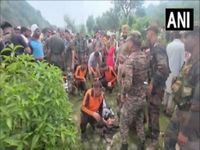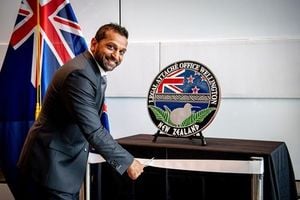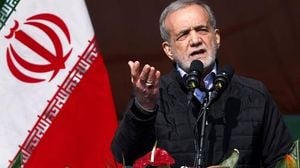On a rain-soaked August evening in the remote hills of Jammu and Kashmir, disaster struck with a ferocity few could have imagined. Flash floods, unleashed by a sudden cloudburst, tore through the tranquil villages of Chasoti in Kishtwar district and Kathua, leaving devastation in their wake. The scenes that followed were harrowing: boulders crashing down mountainsides, homes splintered into debris, and families desperately searching for loved ones swept away by the torrent. Yet amid the chaos, stories of extraordinary courage and resilience emerged, capturing the world’s attention and offering a glimmer of hope in the face of tragedy.
According to reports from ANI and The Times of India, the flash floods on August 14, 2025, hit Chasoti village with particular severity. At least 61 people lost their lives, 116 were injured, and about 70 remained missing in the aftermath. The Rajai Nalla, a usually gentle hillside stream, transformed into a roaring force, carrying away boulders, trees, and even entire homes. A bridge snapped under the pressure, and pilgrims attending the Machail Mata Yatra vanished within seconds as the floodwaters surged through campsites and community kitchens. The devastation in Kathua, meanwhile, claimed five lives and left seven others severely injured, according to Kathua Deputy Commissioner Rajesh Sharma. The injured were airlifted to the military hospital in Pathankot, and many homes were left in ruins.
In the midst of this overwhelming disaster, one image stood out and quickly went viral: Shahnawaz, a member of the State Disaster Response Force (SDRF) from Doda, cradling a 13-month-old girl he had just pulled alive from the rubble in Chasoti. Wearing a navy-blue cap and clutching his ever-present megaphone, Shahnawaz became a symbol of the tireless rescue efforts sweeping through the region. As The Times of India recounted, calls and messages soon poured in from strangers moved by the photograph, some even offering to adopt the rescued infant. But Shahnawaz was quick to clarify, “Her parents have been found. She is with them now, but people don’t believe me.”
The story behind the photo is as dramatic as it is heartwarming. On the evening of August 14, as rescue teams dug through the mud and debris with excavators, Shahnawaz noticed a faint movement—a tiny arm poking out from the wreckage. Without hesitation, he pulled out the child, cleaned her, and wrapped her in a blanket. He then directed his colleagues to free a woman trapped nearby—the girl’s mother, a healthcare worker. Miraculously, both survived. “When the child began to cry, I was happy,” Shahnawaz said, his voice hoarse from hours of shouting warnings and directions through his megaphone.
Later that night, as phone networks flickered back to life, Shahnawaz’s image exploded across social media. “I felt proud that people recognised our work. We gave our 100%. Saving lives brought us happiness,” he reflected. The girl was soon reunited with her father, who had been frantically searching the flood-ravaged area for his family. But there was little time for celebration. The next day, which happened to be India’s Independence Day, Shahnawaz revived another young girl using CPR and mouth-to-mouth resuscitation—a testament to his training and determination.
Shahnawaz’s journey as a rescuer is marked by both hardship and heroism. Having joined the SDRF in 2019, he has faced Kishtwar’s harshest conditions, retrieving bodies from the icy currents of the Chenab River after road accidents in the unforgiving terrain. “Last winter, after pulling bodies from the freezing river, I felt my blood circulation had stopped,” he recalled. Despite the dangers and emotional toll, his family remains supportive and proud of his work. “They’re happy I saved the infant,” he said, managing a smile before turning serious again. “It has drained my voice, but it is part of my job.”
The rescue efforts in Kathua and Kishtwar were nothing short of monumental. The Indian Army, in coordination with the Jammu and Kashmir Police, National Disaster Response Force (NDRF), State Disaster Response Force (SDRF), Border Roads Organisation (BRO), and the local administration, sprang into action. According to Deputy Commissioner Sharma, “There has been a lot of damage to roads and human lives in Kathua. In this village, five people have lost their lives and seven people are injured. The injured have been airlifted to the military hospital in Pathankot... A lot of houses have also been damaged... We are providing food and relief to those who are being evacuated...”
The Central government, too, moved swiftly. Union Home Minister Amit Shah posted on X, “Spoke with the Lieutenant Governor and Chief Minister of Jammu and Kashmir regarding the cloudburst in Kathua. Relief and rescue operations are being carried out by the local administration, and NDRF teams have also been rushed to the site. Assured of every support from the Modi government. We stand firmly behind our sisters and brothers of J&K.”
Efforts to restore essential services in Kishtwar were ongoing. Jammu Divisional Commissioner Ramesh Kumar explained, “There were huge boulders here; they were blasted yesterday. The boulders are being broken down. Rope breakers have been installed due to the possibility that some bodies might be trapped under them. The power supply and water supply have been restored. A bridge is being built here with the help of the Army... All the passengers stranded in Machail were safely evacuated yesterday.” By August 16, all those stranded during the Machail Mata Yatra had been rescued, offering some solace amid the widespread loss.
The political response was not without criticism. J-K Congress President Tariq Hameed Karra described the events as “very tragic” and questioned whether enough had been done to prevent such a disaster. “This is a very tragic incident. We are going to oversee the rescue operations. An advisory was issued 48 hours ago for this, but the question is how people were allowed to go there even after that... There are definitely some gaps in the rescue operations...” he said. Karra also pointed to the broader need for better preparedness: “This is a natural disaster, but we need to see whether the government and its related departments are fully prepared, whether the rescue operations are happening on time or not.”
As dusk settled over the battered landscape of Chasoti, Shahnawaz’s voice—hoarse but resolute—echoed once more, urging villagers to stay away from the treacherous stream. The tragedy in Jammu and Kashmir has laid bare the region’s vulnerability to extreme weather events, but it has also showcased the indomitable spirit of its people and the dedication of those who risk everything to save lives. In the days and weeks ahead, the focus will remain on recovery, accountability, and ensuring that such heartbreak is met with both compassion and action.




